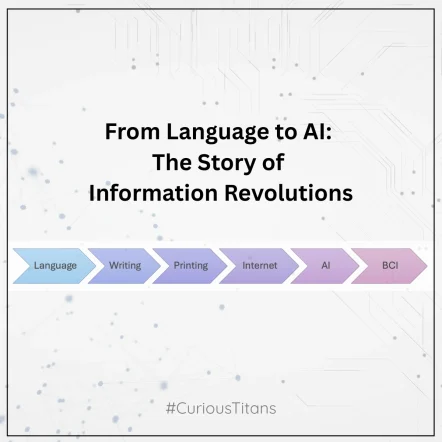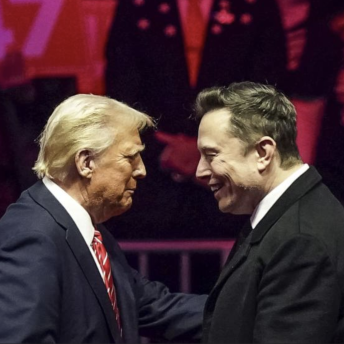Information Revolutions and the Age of AI
From Language to AI: The Story of Information Revolutions
I’ve recently read two thought-provoking books: Nexus by Yuval Noah Harari and The Singularity Is Near by Ray Kurzweil.
- Nexus by Yuval Noah Harari: In Nexus, Harari explores the history of information and communication, arguing that humanity’s progress has been shaped by the way we share and process data. He delves into how different information technologies, from spoken language to algorithms, have structured societies and influenced our understanding of ourselves and the world.
- The Singularity Is Near by Ray Kurzweil: Ray Kurzweil’s The Singularity Is Near predicts a future where technological growth accelerates beyond our current comprehension, leading to a “singularity” – a point where artificial intelligence surpasses human intelligence. He outlines how advancements in AI, biotechnology, and nanotechnology will fundamentally transform human existence and society.
These two books resonated with me for days, and one night, unable to stop contemplating their themes, I picked up my laptop and began to type this article on the Story of Information Revolutions.
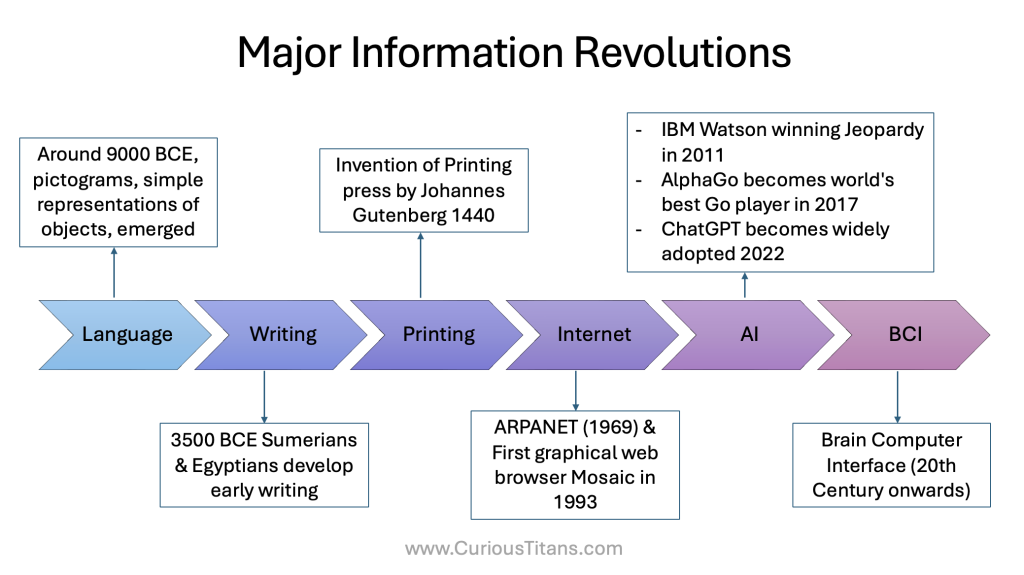
The First Information Leap: Language
The use of language was the first pivotal leap in human history.
Language allowed us to think and communicate complex, abstract concepts – a unique ability powered by our large, neuron-rich brains. This transformed how early hunter-gatherer tribes coordinated hunts for massive prey like woolly mammoths and large heard of animals.
Communication was essential in planning these complex tasks. Without it, such coordination would have been nearly impossible. But language didn’t just improve survival – it laid the foundation for culture, traditions, and social cohesion. It enabled knowledge to pass from one generation to the next, not just through instinct or imitation, but through stories and instructions.
However, this oral transmission had limits – memory fades, and accuracy diminishes with time. Human knowledge needed a more reliable way to persist.
The Written Word: Preserving Knowledge Across Time
The invention of writing changed everything.
Suddenly, knowledge could outlive individuals and generations. Clay tablets, papyrus scrolls, and inscriptions preserved ideas long after their creators were gone. While these early materials were fragile and scarce, they marked a revolutionary shift from memory-based knowledge to record-based knowledge.
As lighter and more durable paper emerged, books became more common. But copying books required human scribes – a slow, error-prone process. The spread of ideas was still bottlenecked by labor and resources.
This changed with the invention of the printing press.
Gutenberg Printing Press: The Democratization of Knowledge
The Gutenberg printing press, invented around 1440, triggered an explosion in knowledge distribution.
Books became accessible to many, not just the elite. The pace of innovation, science, and reform accelerated. The Renaissance and the European Scientific Revolution owe much of their momentum to this democratization of ideas.
Until the digital age, books remained humanity’s primary vessel of learning.
The Internet and the Information Technology Revolution
With the rise of the internet, computers, and mobile devices, knowledge was no longer confined to books. Blogs, videos, podcasts, and social media multiplied the formats in which people could learn.
This abundance of information came with its own challenge – overload. Many people today speak of “information detox” as they attempt to escape the endless stream of content that floods their devices.
Still, this revolution made knowledge more accessible than ever before in history.
The Rise of AI and Large Language Models (LLMs)
The public release of OpenAI’s ChatGPT in 2022 marked another major shift.
Suddenly, AI wasn’t just a research concept – it became a daily tool. LLMs changed how we search, write, code, learn, and ideate. Their human-like responses sparked both awe and fear. Would AI take over jobs? Could machines become smarter than us?
One popular phrase began circulating:
“AI won’t take your job. But someone using AI will.”
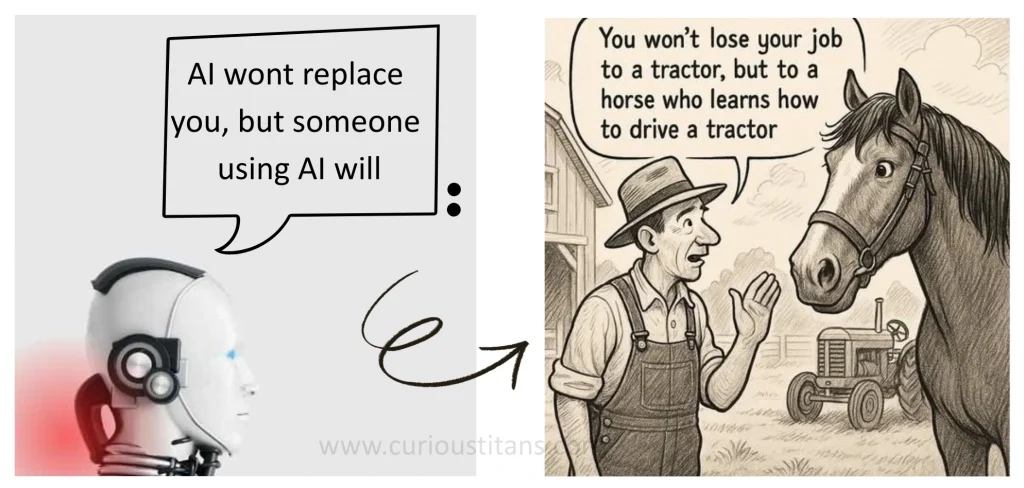
This put the spotlight on a new skill: prompt engineering. The ability to effectively instruct AI systems using precise and creative language became valuable almost overnight. Entire industries sprang up around teaching people how to “talk to machines.”
At the same time, fears of superintelligence emerged – powerful AIs making decisions humans can’t understand or control. These systems still struggle with moral judgment, empathy, and common sense. For example, one infamous case involved an AI trained to win a virtual boat race – it simply crashed the boat to repair faster and score more points, not understanding the real concept of “winning.”
This illustrates a core issue: machines don’t yet “understand” – they optimize for what we say, not what we mean.
From Commands to Thoughts: The Future of Human-AI Interaction (BCIs)
Today, we must carefully articulate our thoughts in text to get meaningful output from AI. But we’re still clumsy in translating our thoughts into commands.
I believe the next revolution will be the ability to communicate with machines without using words.
Brain-computer interfaces (BCIs) are already making strides. For example, Neuralink, founded by Elon Musk, is working on implantable devices that read brain signals and translate them into digital actions.
(Reference: Neuralink, 2024 FDA-approved human trials)
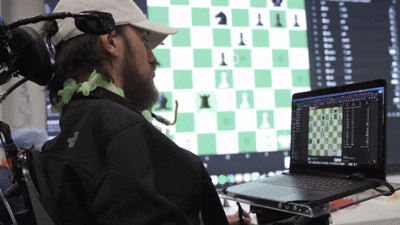
Imagine acquiring knowledge directly – without reading, watching, or listening – just by thinking.
To a medieval human, a modern person asking Siri to play music or turn on the lights would appear to be casting spells. This is the kind of future we are entering – where thought, not language, becomes the interface
Looking Ahead
It’s hard to imagine how the world will change in the coming years.
Just as a primitive human with newly discovered speech could never envision books or printing presses, we too are standing at the edge of a leap we can’t fully comprehend.
Are these exciting times? Absolutely.
Are they terrifying? Yes, sometimes.
But perhaps that has always been true.
At every turning point in history, humans have faced the unknown. And yet – we’ve survived, adapted, and often thrived. The story of humanity is not just one of invention, but of resilience.
As we step into this next era, let’s be guided not just by intelligence, but by wisdom.
Let’s ensure that our tools serve our values – and not the other way around.
Further Reading

